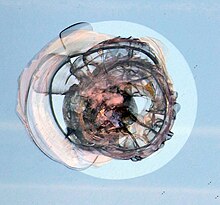
Safety glass is glass with additional safety features that make it less likely to break, or less likely to pose a threat when broken. Common designs include toughened glass (also known as tempered glass), laminated glass, and wire mesh glass (also known as wired glass). Toughened glass was invented in 1874 by Francois Barthelemy Alfred Royer de la Bastie.[1] Wire mesh glass was invented in 1892 by Frank Shuman.[2][3] Laminated glass was invented in 1903 by the French chemist Édouard Bénédictus (1878–1930).[4]
These three approaches can easily be combined, allowing for the creation of glass that is at the same time toughened, laminated, and contains a wire mesh. However, combination of a wire mesh with other techniques is unusual, as it typically betrays their individual qualities. In many developed countries[which?] safety glass is part of the building regulations making properties safer.[5]
- ^ "Glass." The Encyclopædia Britannica : A Dictionary of Arts, Sciences and General Literature. 9th ed. (American reprint). Vol. 10. Philadelphia: Sherman & co., 1894. 595. Print.
- ^ Frank Shuman, "Process of embedding wire-netting in glass", U.S. Patent no. 483,021 (filed: July 6, 1892; issued: September 20, 1892).
- ^ "Northeast Philadelphia Hall of Fame Announces 2012 Inductees" (press release). Mayfair Civic Association, April 26, 2010.
- ^ See:
- Édouard Bénédictus (October 1930), Glaces et verres; revue technique, artistique, pratique, 3 (18): 9.
- Jean-Marie Michel (April 27, 2012), Contribution à l'Histoire Industrielle des Polymères en France, published online by the Société Chimique de France, see Chapter A3: "Le verre renforcé Triplex", page 7.
- French patent 405,881 (registered November 25, 1909).
- ^ Hampton, Simon (15 March 2021). "Safety Glazing Glazing Glass Safety Guide For Landlord 2021". Retrieved 2021-05-16.